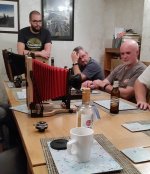I have had two Intrepid 4x5s - a Mark II and a Mark III.
On my first proper outing with the Mark II, the tripod attachment screw snapped whilst I was tightening it. The remains of the screw were stuck in the camera base and I had to send the whole camera back to Intrepid who changed the camera base (at no cost to me),
Later the Mark II was crushed after I fell and landed on my back with the camera in a rucksack. No fault of the supplier and any wooden camera would have been at risk in the same situation.
I replaced the camera, at my cost, with a Mark III which included the ability to swing the back standard and also to tilt the back standard backwards. I'm not certain but I think that the latest model doesn't have these rear standard movements. Omitting them is understandable because it is very difficult to prevent the movements being applied accidentally. The action of fitting the film holder can provide enough force to accidentally tilt the rear standard forward, spoiling your carefully-tuned focus.
Other issues I have experienced include:
a) The screws that hold the bar that moves down to keep the lens board in place have a habit of coming loose, and landing on the ground. On one occasion they disappeared in the grass and the camera was unusable whilst waiting for replacements to be sent (Intrepid did send them, again at no charge to me). I need to carry an allen key to regularly tighten the screws up. The Mark II model actually had a much better screw with a knurled end that could be finger-tightened without tools.
b) The screws that hold a metal plate to the baseboard came loose without warning, leaving no means of attaching the tripod. (Later versions of the camera may not have this plate). Intrepid once again sent me replacement screws without charge, although it was a little worrrying that they had to send two different types of screws because they no longer had a reference Mark III camera (or even the drawings) to check which was the right type.
c) One of the graflock clips on the back broke and was replaced by Intrepid, again free of charge.
d) The knobs on the front standard, which control rise and fall and tilt, got worn after a while and became more difficult to tighten. These were later replaced (free of charge, and without me asking) when the camera was returned to have new bellows fitted.
e) I discovered that the bellows were full of holes when the camera was 3 years old. Whilst the camera was well out of warranty, I was suprised that the bellows deteriorated so quickly. I have cameras over a hundred years old that have perfectly sound bellows. The Mark III did not have user-interchangeable bellows (the latest version does) so I had to send the camera back to have new bellows fitted. The cost was reasonable and the turnaround quick.
More generally, the light weight of the camera is both a strength and a weakness. Easy to carry round but also easy to blow around in the wind, easy to damage, and difficult to keep the standards in the positions you set.
I could have upgraded my Mark III to use the base introduced by the Mark IV, but I chose not to spend the money as I didn't want to throw any more money at the camera and I wasn't convinced that changing the base would solve the problems I was having.
I have now relegated the Intrepid to being used when light weight is the criteria that overrules everything else. So if I was walking five miles with the camera or up a steep hill I would certainly take it. But if I'm walking only a mile from the car I'll take my Horseman monorail instead, even though the camera is about five times as heavy and also needs a more sturdy tripod.
Finally, it is true that Intrepid have been responsive when I have experienced problems, and sent new parts either free of charge, or in the case of the bellows, at a reasonable cost. But I just wish that the camera was more robust in the first place and didn't have these problems.



